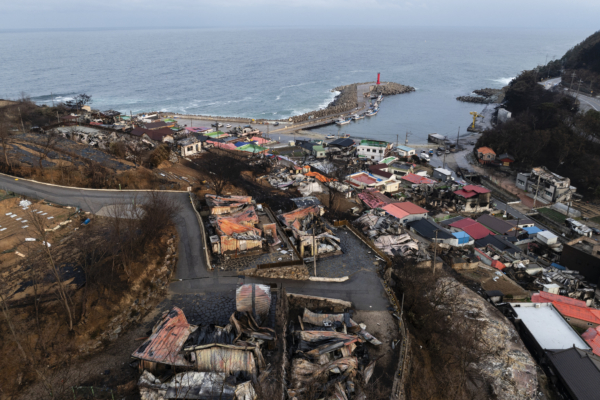During the impeachment of South Korean President Yoon Suk-yeol, the country faced the most severe forest fires in its history, causing unprecedented levels of damage and casualties within a short period of time. Former South Korean Prime Minister Hwang Kyo-ahn suggested that external forces may have been involved in starting the fires based on unusual occurrences during the blaze.
This forest fire, dubbed as the “monster wildfire” by the South Korean public, ravaged multiple regions simultaneously due to dry weather and strong winds. It quickly spread at a terrifying speed, devouring over 40,000 hectares of forest within just a few days, resembling a monstrous entity.
The South Korean Central Disaster Safety Countermeasure Headquarters announced on March 30 that the large-scale forest fires centered around Gyeongsangnam-do and Gyeongsangbuk-do that began on the 21st had been completely extinguished. This unprecedented disaster resulted in 30 deaths, 45 injuries, and more than 48,000 hectares of land burned. Over 3,000 homes were destroyed, along with thirty national heritage sites and over two thousand agricultural facilities damaged.
Among these, the forest fires in Gyeongsangbuk-do were particularly devastating, claiming 28 lives and injuring 37 individuals within a week until the fires were extinguished. The northern part of Gyeongsangbuk-do alone witnessed 24 casualties and the destruction of 23 cultural heritage sites, with the flames threatening the Hahoe Village in Andong City and the nearby Buseoksa Temple, both listed as World Heritage sites.
The South Korean authorities are currently investigating the cause of the most severe fire in the country’s history.
Former Prime Minister Hwang Kyo-ahn pointed out on his Facebook on March 29 that while the primary reason for the widespread forest fires was the hot and dry weather conditions, the possibility of malicious forces taking advantage of the situation cannot be entirely ruled out.
He explained that in the early 1990s, during significant forest fires, Korean police and detectives would immediately investigate for any suspicions related to communist activities. Hwang Kyo-ahn, a former prosecutor, emphasized the ongoing threat posed by North Korea and the lax vigilance against the continuous infiltration by the Chinese Communist Party in South Korea.
Regarding two unusual incidents observed during the fires, one involving a sudden blaze at Mt. Hanpok in Dalseong-gun, Daegu on the evening of March 26, and the other discovering flammable substances sprayed on the ground at the mountaintop trail in Taihang Mountain in Hwaseong City, Gyeonggi-do on March 27, Hwang Kyo-ahn raised doubts about these inexplicable events.
He urged the South Korean firefighting authorities to be vigilant against the possibility of domestic and foreign hostile forces wreaking havoc in the country while thoroughly investigating the causes of the fires.
President Yoon Suk-yeol, awaiting the Constitutional Court’s ruling on the impeachment case, had imposed a brief martial law at the end of last year. He cited the necessity to defend the Republic of Korea from the threats of North Korean communism and pinpointed the existence of “anti-state forces” within the country, including the espionage threats from the Chinese Communist Party.
Renowned speaker Jeon Han-gil questioned on the YouTube channel of Korean media Fntoday on March 28 whether the mountain fires could have been intentionally set by spies, highlighting the possibility of arson in remote and less known areas due to the nature of forest wildfires. He emphasized that actions by North Korea and anti-state elements cannot be discounted.
Fntoday reported on March 27 that the main reasons for the widespread forest fires were attributed to the dry weather and strong winds brought about by climate change. However, the occurrence of over 30 mountain fires simultaneously in a single day was unprecedented, prompting doubts among the government and experts on the official explanations for the nationwide fires.
Additionally, before the outbreak of the massive forest fires, a Chinese exchange student was arrested for arson a month prior. On February 20, the police and fire department in Ulsan, southern Korea, discovered burnt Chinese books and notebooks at the scene where multiple fires were set, leading to the identification of the Chinese student as the suspect behind the arson based on CCTV footage.
Moreover, a statement signed by “All Citizens Safeguarding the Free Republic of Korea” appeared on both domestic and international media on March 23, questioning the rare occurrence of over 31 mountain fires simultaneously across South Korea amidst the ongoing impeachment trial of President Yoon Suk-yeol and the impending second appeal trial of the largest opposition party leader Lee Jae-myung in a significant national moment. The statement drew parallels with the incident involving Lee Seok-ki inciting internal strife and the organized attempts by anti-state elements to disrupt national infrastructure and create chaos in the past.
The statement urged the government to thoroughly investigate any potential instigators behind the intentional chaos related to political events during the wildfires that swept through South Korea.

